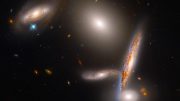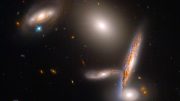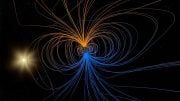Researchers in Canada, the United States, and Europe have developed a new way to remotely measure Earth’s magnetic field—by zapping a layer of sodium atoms floating 100 kilometers above the planet with lasers on the ground.
The technique, documented in Nature Communications, fills a gap between measurements made at the Earth’s surface and at much higher altitude by orbiting satellites.
“The magnetic field at this altitude in the atmosphere is strongly affected by physical processes such as solar storms and electric currents in the ionosphere,” says Paul Hickson an astrophysicist at the University of British Columbia (UBC) and author on the paper.
“Our technique not only measures magnetic field strength at an altitude that has traditionally been hidden, it has the side benefit of providing new information on space weather and atomic processes occurring in the region.”
Sodium atoms are continually deposited in the mesosphere by meteors that vaporize as they enter Earth’s atmosphere. Researchers at the European Southern Observatory (ESO), the University of Mainz, and UBC used a ground-based laser to excite the layer of sodium atoms and monitor the light they emit in response.
“The excited sodium atoms wobble like spinning tops in the presence of a magnetic field,” explains Hickson. “We sense this as a periodic fluctuation in the light we’re monitoring, and can use that to determine the magnetic field strength.”
Hickson and UBC Ph.D. student Joschua Hellemeier developed the photon counting instrument to measure the light coming back from the excited sodium atoms, and participated in observations conducted at astronomical observatories in La Palma.
The ESO team, led by Bonaccini Calia, pioneered world-leading laser technology for astronomical adaptive optics used in the experiment. Project lead Felipe Pedreros and Dmitry Budker (Johannes Gutenberg University), Simon Rochester, and Ronald Holzloehner (ESO), experts in laser-atom interactions, led the theoretical interpretation and modeling for the study.
Reference: “Remote sensing of geomagnetic fields and atomic collisions in the mesosphere” by Felipe Pedreros Bustos, Domenico Bonaccini Calia, Dmitry Budker, Mauro Centrone, Joschua Hellemeier, Paul Hickson, Ronald Holzlöhner and Simon Rochester, 28 September 2018, Nature Communication.
DOI: 10.1038/s41467-018-06396-7










This appears by the descriptive phrase to be a modification of the laser adaptive flexable lens system developed 15 years ago to get ground based observation up to satellite quality. the lasers sound far more powerful though, enough to punch through our entire atmosphere and heat sodium past its first enthalpy.